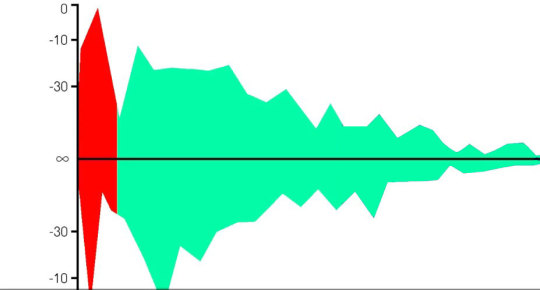
To understand compression, what it is, how it works, why it’s used and its effect on sound, one must first understand a little bit about the properties of sound. Bear with me there as it can be a bit technical, but I will do my best to explain things a simply as possible.
It’s actually easier than it looks on the schema above and we’re going to simplify it in even further in our explanation, because unless you aim to be a sound engineer or someone who is designing sounds on a synthesizer, you really don’t need to go too far into the details…
Each sound we hear can be described by many factors, but 2 of the most important ones (and the ones affected by compression) are Time and Amplitude. Time being how long the sound plays, and Amplitude being its volume/level.
Now during the “life” of a sound there are many phases. In synthesizer parlance this is called ADSR, or Attack/Decay/Sustain/Release. For our purpose we can forget about Decay and Release and simplify it into two main phases of the life of a sound by talking about Attack and Sustain only, the red and green parts below:

Think of a single snare drum hit. The main hit will be the
Attack and the ringing of the snare will be its Sustain.
The Attack of a snare will be very fast and short, it will peak very fast to
its highest level, but it will not stay long at this high level, instead it
will very shortly decay and what we’ll hear is the Sustain or the “tone” of the
snare, which can be long or not (and can be enhanced by the natural
reverberation of the room it’s been recorded in).
For other sounds it might be different, for example a flute will have a rather long attack, and its sustain will be short or long depending on how much breath the musician has. In any case these two main phases will differ greatly depending on whether a sound is percussive or not.
The attack part of a sound is often referred to as Transients. As it turns out, one of the compressor’s purpose will be to work on Transients vs Sustain, affecting the relative levels of these two in various ways, thus changing the sound.
A compressor will affect the Amplitude of a sound in time, at its core it’s nothing but a volume control! But one that can act extremely fast and affect different phases of the sound independently.
We will see that it also changes the perceived loudness (and dynamic range) of a sound, because it can affect the Transient differently than the Sustain, making it sound bigger (but not necessarily better!).
To note finally, that when it comes to bigger/better, our ears are such that when we hear the same sound at different volume levels, we’re always going to prefer the louder sound, even if they are perfectly identical. In a lot of cases, given a sound A and B, even if A is sounding better than B, when B is played louder there is a good chance we will prefer B. That’s how our brain works and how the effect of compression is going to get really tricky…
Tune in to learn more about that as we go along!
